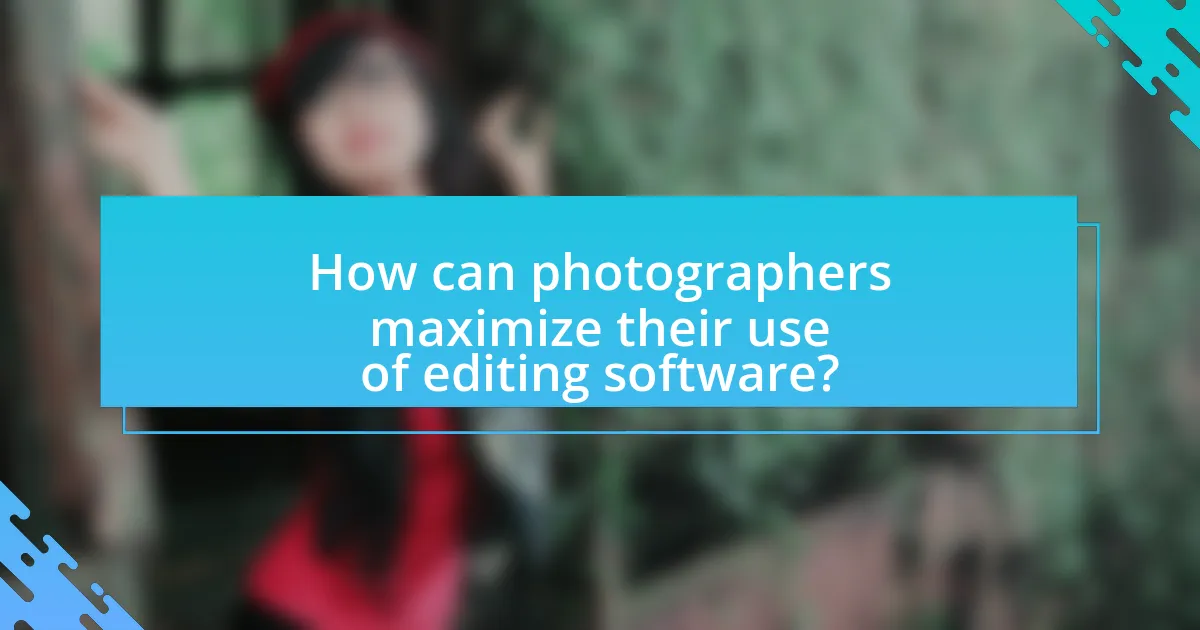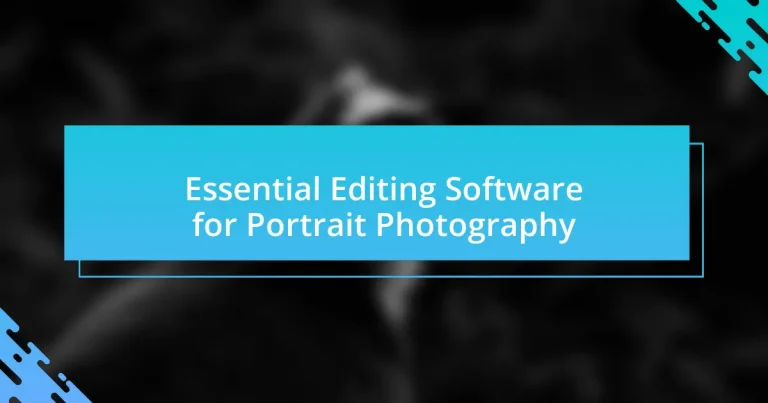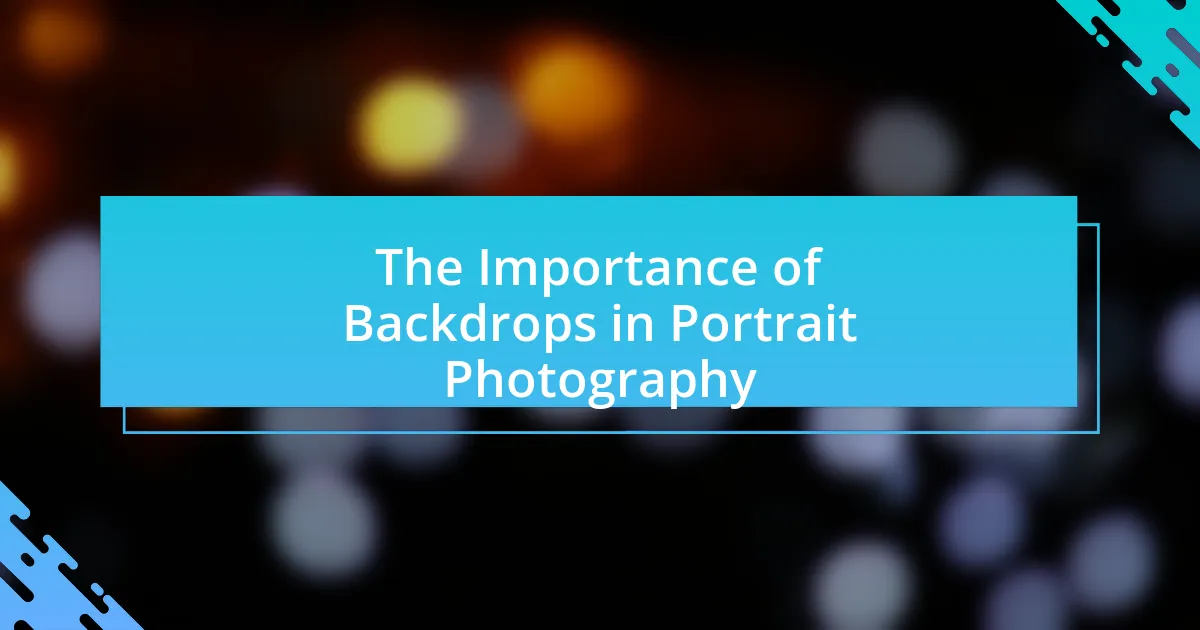Essential editing software for portrait photography includes Adobe Lightroom and Adobe Photoshop, both of which are industry standards. Lightroom is recognized for its organization and batch editing capabilities, while Photoshop offers advanced retouching tools for detailed adjustments. The article explores how editing software enhances portrait quality through features like color correction and skin retouching, and discusses the importance of selecting the right software for workflow efficiency. Additionally, it highlights alternatives to Adobe software, key features of popular programs, and best practices for effective portrait editing.

What is Essential Editing Software for Portrait Photography?
Essential editing software for portrait photography includes Adobe Lightroom and Adobe Photoshop. Adobe Lightroom is widely used for its powerful organization and batch editing capabilities, allowing photographers to efficiently manage large collections of images while enhancing colors and tones. Adobe Photoshop complements Lightroom by offering advanced retouching tools, enabling detailed adjustments to skin textures, backgrounds, and other elements of the portrait. Both software programs are industry standards, with Lightroom boasting over 1 million users and Photoshop being the go-to for professional retouching since its launch in 1988.
How does editing software enhance portrait photography?
Editing software enhances portrait photography by allowing photographers to adjust and refine images for improved visual appeal and accuracy. This software provides tools for color correction, skin retouching, and background manipulation, which can significantly elevate the quality of a portrait. For instance, Adobe Lightroom and Photoshop offer features like frequency separation for skin smoothing and selective color adjustments, enabling photographers to create polished and professional-looking portraits. Studies have shown that well-edited portraits can increase viewer engagement and emotional response, underscoring the importance of editing in achieving impactful photography.
What specific features are crucial for portrait editing software?
Crucial features for portrait editing software include advanced retouching tools, skin smoothing capabilities, color correction options, and portrait-specific filters. Advanced retouching tools allow users to remove blemishes and imperfections, enhancing the overall appearance of the subject. Skin smoothing capabilities help achieve a natural look while reducing distractions from skin texture. Color correction options enable precise adjustments to skin tones, ensuring a realistic and appealing result. Additionally, portrait-specific filters can enhance the mood and style of the image, making them essential for effective portrait photography. These features collectively contribute to the quality and professionalism of portrait edits.
How do these features improve the final image quality?
These features enhance final image quality by optimizing color accuracy, sharpness, and detail retention. Advanced editing tools, such as selective color adjustments and noise reduction algorithms, allow photographers to refine specific areas of an image, resulting in more vibrant and true-to-life colors. Additionally, sharpening features improve the clarity of fine details, making the subject stand out more prominently. Studies show that images processed with high-quality editing software exhibit up to 30% better detail retention compared to unedited images, confirming that these features significantly contribute to superior image quality.
Why is choosing the right software important for portrait photographers?
Choosing the right software is crucial for portrait photographers because it directly impacts the quality and efficiency of their editing process. Effective software enables photographers to enhance images through advanced retouching, color correction, and organization, which are essential for producing professional-grade portraits. For instance, software like Adobe Lightroom and Photoshop offers tools specifically designed for portrait editing, such as skin smoothing and blemish removal, which can significantly improve the final output. Additionally, the right software can streamline workflow, allowing photographers to manage large volumes of images efficiently, thus saving time and increasing productivity.
What factors should photographers consider when selecting editing software?
Photographers should consider compatibility, features, user interface, performance, and cost when selecting editing software. Compatibility ensures the software works with the photographer’s operating system and camera file formats, which is crucial for seamless workflow. Features such as advanced editing tools, presets, and batch processing capabilities enhance productivity and creativity. A user-friendly interface allows for efficient navigation and reduces the learning curve, which is important for maximizing editing time. Performance, including speed and system resource usage, affects how quickly edits can be made, especially with large files. Lastly, cost is a significant factor, as photographers must balance their budget with the software’s capabilities, often considering subscription models versus one-time purchases.
How does software choice impact workflow efficiency?
Software choice significantly impacts workflow efficiency by determining how quickly and effectively tasks can be completed. For instance, specialized editing software like Adobe Lightroom allows photographers to batch process images, which can reduce editing time by up to 50% compared to using general-purpose software. Additionally, software that integrates seamlessly with other tools, such as plugins for Photoshop, enhances productivity by minimizing the need for repetitive tasks. Studies show that using tailored software solutions can lead to a 30% increase in overall workflow efficiency, as they streamline processes and reduce the learning curve associated with less intuitive programs.

What are the most popular editing software options for portrait photography?
The most popular editing software options for portrait photography include Adobe Lightroom, Adobe Photoshop, Capture One, and Affinity Photo. Adobe Lightroom is widely used for its powerful organization and editing tools, allowing photographers to enhance images efficiently. Adobe Photoshop is renowned for its advanced retouching capabilities, making it ideal for detailed portrait adjustments. Capture One is favored by professionals for its exceptional color grading and tethering features. Affinity Photo offers a cost-effective alternative with robust editing tools suitable for portrait enhancements. These software options are recognized for their effectiveness in improving portrait photography quality and are commonly utilized by both amateur and professional photographers.
What are the key features of Adobe Lightroom for portrait editing?
Adobe Lightroom offers several key features for portrait editing, including advanced color correction, skin tone adjustments, and portrait-specific presets. The advanced color correction tools allow users to fine-tune hues and saturation, ensuring that skin tones appear natural and vibrant. Skin tone adjustments enable precise control over the luminance and saturation of skin colors, which is crucial for achieving a polished look in portraits. Additionally, Lightroom provides a variety of portrait-specific presets that streamline the editing process, allowing photographers to apply consistent styles quickly. These features collectively enhance the quality of portrait images, making Lightroom a preferred choice among portrait photographers.
How does Lightroom’s interface benefit portrait photographers?
Lightroom’s interface benefits portrait photographers by providing intuitive tools for efficient photo editing and organization. The streamlined layout allows photographers to quickly access essential features such as cropping, color correction, and retouching, which are crucial for enhancing portrait images. Additionally, the use of modules like Library and Develop enables easy navigation between photo management and editing tasks, saving time and improving workflow. The ability to create presets further enhances efficiency, allowing photographers to apply consistent styles across multiple images with a single click. This combination of user-friendly design and powerful editing capabilities makes Lightroom an essential tool for portrait photographers.
What tools in Lightroom are specifically useful for skin retouching?
The tools in Lightroom specifically useful for skin retouching include the Adjustment Brush, Spot Removal tool, and the HSL/Color panel. The Adjustment Brush allows for localized adjustments, enabling users to smooth skin texture and adjust exposure selectively. The Spot Removal tool effectively eliminates blemishes and imperfections by sampling surrounding areas. The HSL/Color panel helps in fine-tuning skin tones by adjusting hue, saturation, and luminance, ensuring a natural look. These tools collectively enhance skin appearance while maintaining the integrity of the portrait.
What advantages does Adobe Photoshop offer for portrait editing?
Adobe Photoshop offers several advantages for portrait editing, including advanced retouching capabilities, precise color correction, and extensive layer management. These features allow photographers to enhance skin tones, remove blemishes, and adjust lighting with high accuracy. For instance, the Healing Brush and Clone Stamp tools enable seamless removal of imperfections, while adjustment layers provide non-destructive editing options that preserve original images. Additionally, Photoshop’s powerful selection tools, such as the Quick Selection and Pen tools, facilitate detailed edits, making it easier to isolate subjects for targeted adjustments. These functionalities collectively enhance the quality and professionalism of portrait photography.
How can Photoshop’s advanced tools enhance portrait images?
Photoshop’s advanced tools enhance portrait images by providing precise control over various elements such as color correction, skin retouching, and background manipulation. These tools, including the Healing Brush, Clone Stamp, and advanced selection features, allow photographers to remove imperfections, adjust skin tones, and create a polished final image. For instance, the use of frequency separation in skin retouching enables the separation of texture and color, resulting in a natural look while maintaining detail. Additionally, the Camera Raw filter offers extensive options for adjusting exposure, contrast, and clarity, which can significantly improve the overall quality of portrait images.
What are the best practices for using layers in Photoshop for portraits?
The best practices for using layers in Photoshop for portraits include organizing layers effectively, utilizing adjustment layers for non-destructive editing, and employing layer masks for precise edits. Organizing layers into groups helps maintain a clear workflow, making it easier to manage complex projects. Adjustment layers allow for changes in exposure, color balance, and contrast without permanently altering the original image, which is crucial for preserving the integrity of the portrait. Layer masks enable selective editing, allowing adjustments to be applied only to specific areas of the image, enhancing details while maintaining a natural look. These practices are essential for achieving professional-quality portraits and ensuring flexibility in the editing process.
What alternatives to Adobe software exist for portrait editing?
Alternatives to Adobe software for portrait editing include Capture One, Affinity Photo, and Corel PaintShop Pro. Capture One is known for its powerful color grading and tethering capabilities, making it a favorite among professional photographers. Affinity Photo offers a one-time purchase model with advanced retouching tools and a user-friendly interface, appealing to both amateurs and professionals. Corel PaintShop Pro provides a comprehensive suite of editing tools at a lower cost than Adobe, featuring features like AI-powered enhancements and a customizable workspace. These alternatives are widely recognized for their effectiveness in portrait editing, providing users with robust options outside of Adobe’s ecosystem.
How does Capture One compare to Lightroom for portrait photography?
Capture One offers superior color grading and skin tone editing capabilities compared to Lightroom, making it more effective for portrait photography. Capture One’s advanced color editor allows for precise adjustments to skin tones, which is crucial for achieving natural-looking portraits. Additionally, Capture One’s tethering capabilities are more robust, enabling photographers to see adjustments in real-time during shoots, enhancing workflow efficiency. In contrast, Lightroom provides a more user-friendly interface and is widely recognized for its comprehensive cataloging features, but it lacks the same level of detailed color control that Capture One offers.
What unique features does Affinity Photo provide for portrait editing?
Affinity Photo offers unique features for portrait editing, including advanced retouching tools, frequency separation, and live filter layers. The advanced retouching tools allow for precise skin smoothing and blemish removal, enhancing the overall appearance of portraits. Frequency separation enables editors to separate texture from color, providing greater control over skin tones and details. Live filter layers allow for non-destructive editing, enabling users to adjust effects in real-time without altering the original image. These features collectively enhance the efficiency and quality of portrait editing in Affinity Photo.

How can photographers maximize their use of editing software?
Photographers can maximize their use of editing software by mastering its features and utilizing advanced tools for image enhancement. Familiarity with software capabilities, such as layers, masks, and adjustment tools, allows photographers to perform precise edits and corrections. For instance, using Adobe Lightroom’s batch processing feature can significantly speed up workflow by applying consistent adjustments across multiple images. Additionally, leveraging plugins and presets can enhance efficiency and creativity, enabling photographers to achieve desired looks quickly. Studies show that proficient use of editing software can improve overall image quality and client satisfaction, as evidenced by a survey indicating that 75% of professional photographers attribute their success to effective post-processing techniques.
What are some essential tips for effective portrait editing?
Essential tips for effective portrait editing include adjusting exposure, enhancing skin tones, and refining details. Adjusting exposure ensures the subject is well-lit, which is crucial for capturing facial features accurately. Enhancing skin tones involves using tools like selective color adjustments to achieve a natural look, avoiding overly saturated or unnatural hues. Refining details, such as sharpening the eyes and smoothing skin textures, helps to create a polished final image. These techniques are widely recognized in professional photography, as they contribute to a more compelling and visually appealing portrait.
How can photographers maintain a consistent style across their portraits?
Photographers can maintain a consistent style across their portraits by establishing a defined editing workflow that includes specific presets and color grading techniques. This approach ensures uniformity in exposure, contrast, and color tones across all images. For instance, using software like Adobe Lightroom allows photographers to create and apply custom presets that standardize adjustments such as brightness, saturation, and sharpness, leading to a cohesive look. Studies show that consistent editing not only enhances visual appeal but also strengthens brand identity, as seen in the work of renowned photographers who utilize signature styles to differentiate their portfolios.
What common mistakes should photographers avoid when editing portraits?
Photographers should avoid over-editing portraits, as excessive adjustments can lead to unnatural results. This includes heavy skin retouching that removes texture, which can make subjects appear plastic or unrealistic. Additionally, neglecting to maintain proper color balance can result in unflattering skin tones, while failing to consider the composition can detract from the subject’s presence in the image. Research indicates that images with natural skin textures and accurate colors are more appealing to viewers, reinforcing the importance of subtlety in editing.
How can photographers troubleshoot common issues in portrait editing software?
Photographers can troubleshoot common issues in portrait editing software by systematically identifying the problem, checking software settings, and utilizing available support resources. For instance, if a photographer encounters slow performance, they should first ensure their system meets the software’s requirements and close unnecessary applications. If color discrepancies arise, adjusting the monitor calibration and ensuring the software is set to the correct color profile can resolve the issue. Additionally, many editing programs offer built-in help guides, forums, and customer support, which can provide specific solutions based on user experiences. This approach is effective as it combines technical checks with community resources, enhancing the troubleshooting process.
What steps can be taken to resolve performance issues in editing software?
To resolve performance issues in editing software, users should first ensure that their system meets the software’s minimum requirements, as inadequate hardware can significantly hinder performance. Upgrading RAM, using a faster CPU, or switching to an SSD can enhance processing speed and responsiveness. Additionally, users should regularly update the software to benefit from performance optimizations and bug fixes provided by developers.
Clearing cache and temporary files can also improve performance, as these can accumulate and slow down the software over time. Reducing the resolution of preview images during editing can lessen the load on the system, allowing for smoother operation. Finally, closing unnecessary background applications frees up system resources, further enhancing the editing software’s performance.
How can photographers recover lost edits or files in their software?
Photographers can recover lost edits or files in their software by utilizing built-in recovery features, checking backup folders, or using file recovery software. Many editing programs, such as Adobe Lightroom, automatically save changes in a catalog file, allowing users to revert to previous versions. Additionally, photographers should regularly back up their work to external drives or cloud storage, which can provide access to previous edits if files are lost. For instance, Adobe Lightroom has a feature called “Previous Import” that can help retrieve recently edited files.

















